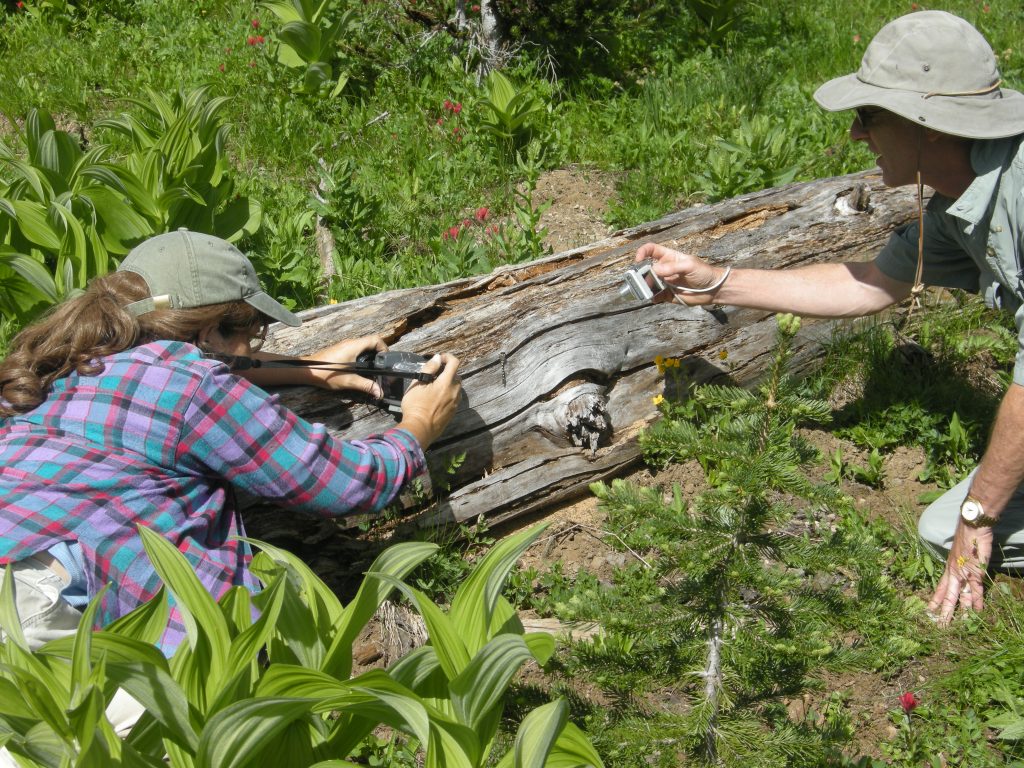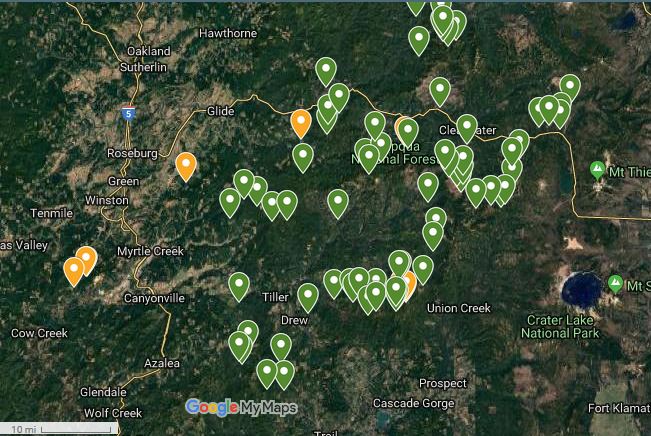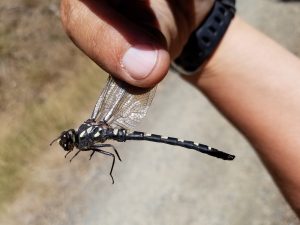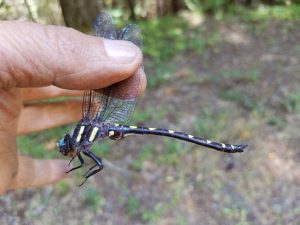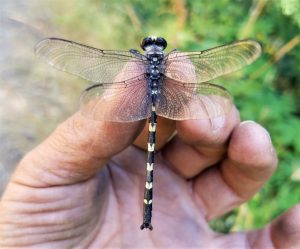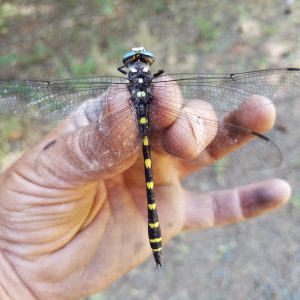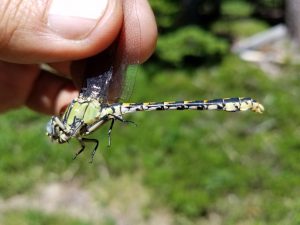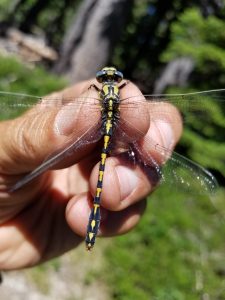Are you ready to go look for Black Petaltails? This post will tell you where, when, and how to look for Black Petlatails for this Umpqua Basin study, and what to do if you find them or don’t find them. Be sure you’ve read through the first two posts thoroughly and signed up to receive email updates (signup form is at bottom of each petaltail post): first post, second post. Then, dive in below!
A Little Background on Dragonflies in Oregon
A little over 90 species of dragonflies and damselflies (total) have been found in Oregon; about 70 species in Douglas County. Of these, about 2/3 are dragonflies and 1/3 damselflies (many informational resources can be found at Jim Johnson’s page). A great beginning resource for learning about dragons and damsels in Oregon is the book “Dragonflies and Damselflies of Oregon,” by Cary Kerst and Steve Gordon. The online site iNaturalist includes photos of 65 species encountered in recent years in Douglas County.
Where to Look
If you have not yet chosen and/or been assigned a location, go to the Black Petaltail Data Page and look on the map or table for an area you would like to visit or explore. Then let me know what you decide so I can assign the location to you. If you are out exploring and you find additional areas or change your mind, that’s fine, just keep in touch with me about where you’re going and what you’re finding or not finding! Thanks!
Once you are “in the hills” at a location you want to search, whether it is a roadside seep or a huge meadow, you will want to find the best petaltail habitat and perch locations. An ideal spot will have wet, mucky ground, with some slowly seeping water, and some perches nearby such as logs or rocks. To look for the adults, check these likely perches and look for anything flying around. Do not worry about any dragonflies that are flying more than about 8 feet above the ground. These are less likely to be petaltails and it would be difficult to tell even if they were. You want to focus on dragonflies that are flying lower, where you can see them, and you want to keep your eye on them until they land. That will give you an opportunity to see them better and hopefully get pictures.
If you are proficient with a net, you may attempt to net flying dragonflies, but typically if you wait just a few minutes you will see one perch. That is your opportunity to attempt a photo.
Whether or not you see flying adults, keep your eye out for burrows in the muck, or empty exoskeletons of the petaltail still grasping on to the wetland vegetation (see photo below and first and second posts for more photos of burrows and nymphs).
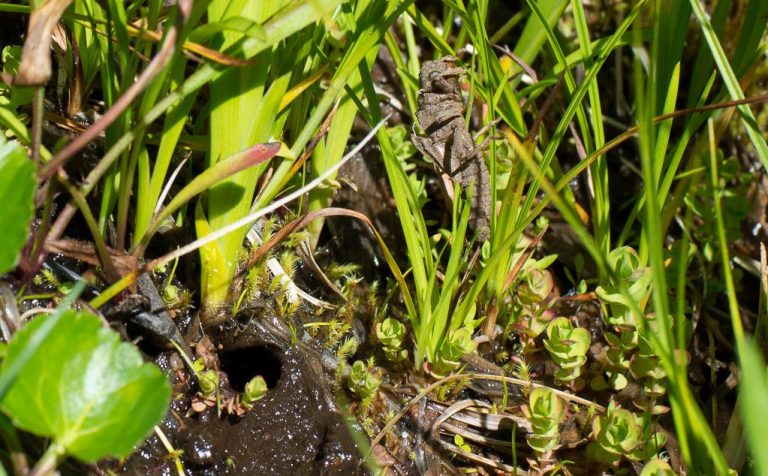
When to Look
Mid-June to early August is the best time of year. Like many insects, birds, and other animals, seasonal activity is fairly specific. The earliest and latest known dates for adults flying in Oregon are May 24 and September 7, respectively (see Jim Johnson’s compilation here). However, the majority of adults are flying from about mid-June to the end of July most years.
11:00 a.m. to 3:00 p.m. is the best time of day on average. As with season, there are particular times of day when Black Petaltails are most active, with some variation likely due to temperature and cloud cover. On very warm and sunny days, petaltails may be out sunning by 9 a.m. or earlier, whereas on cooler overcast days, they may not be visible until closer to noon. Similarly, on nice warm days, they may fly until perhaps 6 p.m., whereas on cooler days or shady locations they may go roost for the night by 3 or 4 p.m.
Is That a Black Petaltail?
If you are in good petaltail habitat–a wet, mucky somewhat sloping meadow high in the mountains–it is unlikely you will see any other dragonfly species that looks similar to the Black Petaltail, with a bold black and yellow pattern. You might see some very small damselflies, but these are tiny compared to the petaltail and mostly blue or brown. You might see some smaller species of dragonfly, but these are usually either reddish, yellowish, or if they are blackish, they don’t have the strong yellow marks on the abdomen or the same marks on the sides of the thorax. You might see some large “darners,” but these usually have more blue or green color, sometimes brown and yellow and almost never land.
The best way to prepare yourself to identify Black Petaltails and to distinguish them from a few similar species, is to first become familiar with the Black Petaltail itself. The Black Petaltail has these features:
- Just over 2 inches long (53-55 mm)
- Mostly clear wings with a long thin pterostigma (the long black mark at the outer leading edge of each wing.
- Mostly black body (thorax and abdomen) with a cluster of yellow spots and dashes on the sides of the thorax, and a number of small yellow saddles across the abdomen that are shorter in length than the black between them.
- Deep brown eyes separated from each other, not touching in the middle.
- White face between and in front of the eyes.
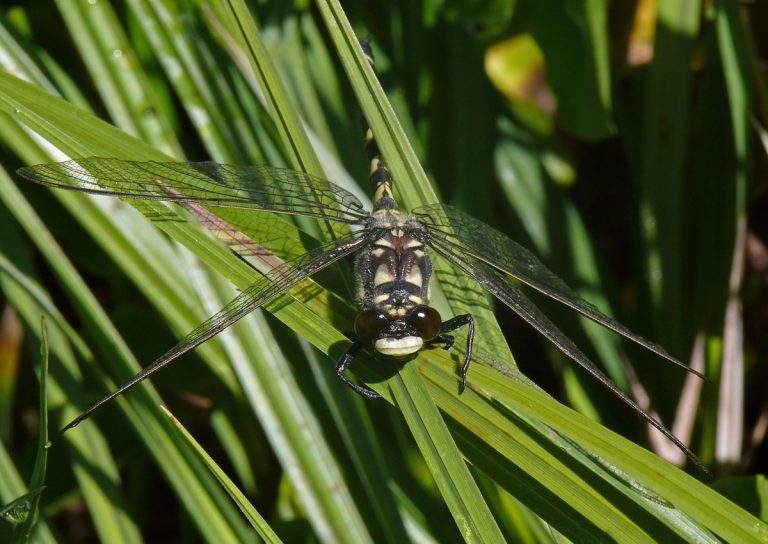
There are a couple species that you may encounter in certain circumstances that look somewhat like the petaltail. I will describe those and how you can tell they are not petaltails.
The first is the Pacific Spiketail (Cordulegaster dorsalis). This species occurs along small streams and nearby meadows and roads. Sometimes, if there is a small stream through a meadow, or water flowing in a road ditch, a Pacific Spiketail will be cruising slowly over this water or along the road. The spiketail also has a black and yellow pattern on its abdomen. However, there are several differences that will tell you that it is not a Black Petaltail: 1) You probably won’t see it perch, but if it does perch it will hang vertically from a twig or other piece of vegetation, not flat against a rock or log, 2) It has blue eyes, not brown eyes of the petaltail, 3) The spiketail has two big bold yellow stripes on the sides of its thorax (the bulky body part right under the wings), rather than the multiple yellow spots and dashes of the petaltail, 4) The spiketail is also noticeably longer than the petaltail, but you wouldn’t be able to tell that until you see a few of both species.
One other possibility, is one of the “clubtails” or “snaketails” such as a Pacific Clubtail (Phanogomphus kurilis) or a Great Basin Snaketail (Ophiogomphus morrisoni). These are normally along small open-canopied sunny streams or lakes, but may occasionally wander to a nice meadow. Like the petaltail they often fly low and will perch on logs, rocks, and the ground. So, here’s how to be sure you have a petaltail versus one of the clubtails: 1) the Black Petaltail has brown eyes and a white face, whereas the clubtails and snaketails have bluish or grayish eyes with an off-white or yellowish or greenish face, 2) the yellow marks on the petaltail abdomen are shorter than the longer black in between, but the yellow goes all the way across the abdomen, whereas on the clubtails and snaketails the yellow marks on top of the abdomen are usually longer than the dark sections, and on the males the yellow is constricted into yellow points or arrow shapes. In summary, more black on the petaltail, more yellow or pointy yellow on the clubtails and snaketails.
Use Binoculars
You may encounter dragonflies that are not quite close enough for you to see details with your eyes only. However, with binoculars you should be able to see the detail necessary to reveal whether a dragonfly you have spotted is a Black Petaltail or not, and whether you want to attempt closer approach for a photograph. If you have a big zoom lens, you may not need to do this, but I do not expect many to have such equipment.
Data to Collect
For every site you search (whether or not you find Black Petaltails), record the following information:
- Your name(s)
- Date and time of search (beginning and end)
- Name of site (or give it a name)
- GPS coordinates somewhere in the site
- A short description of where it is located or give directions.
- Brief description of habitat and any water
- What you found in terms of dragonflies. Did you find any Black Petaltails? How many? Adults? Burrows? Nymphs? Exuviae? Where exactly within the larger site did you find these? Give coordinates and/or a description of the exact location if you can. Were there other dragonflies? If you do not find any petaltails, that is important information too, so please let me know!
- Anything else you’d like to share about the site.
Take Photographs
In contrast to many other species of large dragonfly, the Black Petaltail fairly regularly lands in plain view on the ground, a log, rock, or even your shirt or pants. It merely takes some patience to watch the dragonfly until it lands, and then you may approach slowly to photograph. If you have a camera zoom capability, I recommend using that; however, as you can see in the featured photo at the top of this post, Black Petaltails can sometimes be approached close enough to use a cell phone. You do not need to get full-frame photos, but about 1/20th frame size or larger is good. Just do your best. Tip: start taking photos as soon as you can, even if you can barely see the dragonfly, then move closer taking more photos.
If you look for and find any nymph burrows or exuviae (see above, and first and second posts), be sure to take photos of them as well. If you find what you believe are petaltail exuviae, you may collect one or more of these as voucher specimens.
Finally, it would be great to take at least one representative photo of the habitat that you searched. I would like to include these in my database of sites searched.
Mosquitos and Other Bugs
You will likely be visiting some damp areas during the peak of mosquito season. Be prepared with your choice of spray or lotion, and/or comfortable long sleeved shirts and long pants. If things are really bad, you can wear a bug net over a wide-brimmed hat. One never knows if it is going to be a bad or a tolerable year for mosquitos, so I prefer to go prepared for the worst and hope for the best.
Have Fun, Be Safe, and Communicate
Please enjoy yourself and your surroundings, don’t take big risks for this project, and please let others know where you will be going and when. Finally, it will make me happier than anything to hear from you often on where you’re going and what you’re finding, and any questions you have. I will be out in the field too, and occasionally will not have cell service, but please call, email, text, or whatever you like to let me know what’s happening.
Sign Up
If you would like to participate in this project either by helping me identify potential sites or searching for Black Petaltails in beautiful mountain meadows in early summer of 2019, or both, please sign up with the form below so I can provide more information and updates. (Note: as you scroll down you may also see a form pop up where you can sign up to receive email notification of all my blog posts–I hope you’ll do that too.
